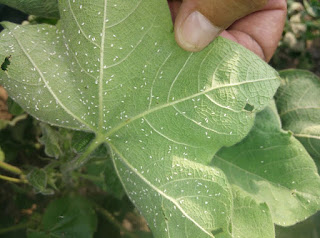Bt cotton Backlash- A reality to face in the coming years
Yesterday, I got a telephonic call from my relative, Mr Narayan who resides in the remote village in Barwani district of Madhya Pradesh. Narayan is an educated intelligent farmer, about 35 years old, who knows more economics of crop cultivation than I do. He told me that from next year onward, he is going to sow non-Bt local cotton varieties in his fields. He is the same guy who used to ask me for sources of Bt cotton seeds which were at one time in short supply and were sold in black market during early years of Bt cotton commercialization in the country. Some years ago, I argued with one of the leading farmers from Akola who told me that Bt cotton is not performing as well. I am a votary of Bt cotton (and eventually Bt or GM technology) because it is hard core science that has solved bollworm problem when the American bollworm was a menace before 2002. This key pest feeds on bolls causing direct loss of crop yields. It used to damage crop regularly and was in outbreak form almost every five years’ interval. Not only cotton, but other crops were also damaged. And over the years, farmers continued to aim for its control with best of insecticides and with lot of them, until this pest developed resistance, integrated pest management remained of limited use, and economics of crop production dwindled. In 1980s farmers committed suicides, as they realised inability of reimbursing loans that they had taken in expectations of its control on otherwise bumper looking crop. The hiatus continued on and off until 2002 and even later for various other reasons.Back to yesterday’s telephonic talk, this time I felt that there is something seriously wrong. Narayan told me that cotton productivity has declined due to pest damage, and increasing cost of crop production. When reminded of bollworm damage on the non-Bt cotton that used to occur prior to Bt cotton introduction in 2002, he told me that sucking pests are biggest headache now and are difficult to control. By growing non-Bt local cotton, he aims to control sucking pests as these local varieties are more tolerant of them and as far as bollworm is concerned, it is back to chemical control as bollworms will be less damaging in view of low infestation of the American bollworm and probably of pink bollworm too.Is Narayan only one farmer to turn to non-Bt cotton cultivation? Probably not. It is likely that there are many more like him. Do they count? Not much. The data on Bt cotton area does not show any decline; nor of non-Bt cotton a substantial increase. Bt cotton area is in between 90 and 96% of total cotton area. But it is a trend that is showing up, as frustration with increasing costs of cultivation mounts.But this talk has set in something that I missed in the past. Looking into the data on insecticide use on Bt cotton for the period of 2002-2011compiled by Kranthi and Reddy in 2012, I find that insecticide use on cotton for bollworm has declined since Bt cotton in 2002, but total insecticide use on Bt cotton has increased due to sucking pests; and in terms of quantity it is as much as it was 10 years before. Obviously this also means in the areas of intensive cultivation, farmers may have been using more insecticides on cotton than ever before in the hope of high production. Looking at the figures on monetary value of insecticides on cotton, the farmers spent more almost double (about Rs 991 Crores) in 2011-12 as compared to expenditure of Rs 597 Crores in 2002 on insecticides. And it is the same story on basis of per hectare pesticide cost too. And this is about 7-8 years ago. And the situation in 2019 could be equally a good guess to be true. Further, add to this other costs of cultivation like those for fertilizer, weeding and harvesting.Like last years’ poor production, this years’ production too may not cheer up the farmers, for the excess and untimely rains in many cotton growing areas in the South and Central India. The production estimates vary a lot and likely to be less than 35 million bales from 12.8 million hectares of sowing. Prices are dampening the spirit, as we hear of US-China trade deal. Cotton productivity is stagnating over the past one decade or even more. Narayan may not know or care to know what is happening at the National level, but surely know how to act at local level. It is now time to look for change or update in the cotton agronomy and technology, as no new technology is likely to be introduced like that of Bt cotton from abroad; until then for the farmer like him it is completing a full circle where he started in 2002.




Comments
Post a Comment